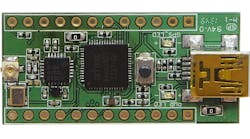A new development board aims to bring the latest satellite navigation technology into the hands of makers. NavSpark combines a 100-MHz, 32-bit microcontroller (MCU) board with a small global positioning system (GPS) receiver. In doing so, it eliminates the need for an additional GPS shield, which can add unnecessary cost and bulk. Funding for this Arduino-based board is currently being sought via an Indiegogo crowdfunding campaign.
The NavSpark board is built around a 55-nm Venus 822 chip. It flaunts sufficient performance to simultaneously process signals from a combination of 34 GPS, Global Navigation Satellite System (GLONASS), Beidou, and Galileo satellites in parallel. Such capability is supported by 1024 kBytes of Flash memory and 212 KB of random-access memory (RAM). The board supports Arduino IDE (with custom integration of Wiring libraries and the Windows platform) and is breadboard compatible. An alternate model of the board, NavSpark-BD, utilizes a GPS/Beidou receiver as on-board peripheral.
Measuring just 38 x 18 mm, the board is powered and programmed by a mini-USB connector. It has 17 digital I/O pins including: one full-duplex universal asynchronous receiver/transmitter (UART), one UART transmitter, two serial-peripheral-interface (SPI) buses with master/slave mode configurability, one inter-integrated circuit (I2C), and one 24-bit pulse-width modulator (PWM).
Although the crowdfunding will show if there is sufficient interest in the technology, NavSpark is suited to a variety of applications. It can be used as a data logger to relay position, velocity, and time information to an external SPI Flash, which can later relay flight paths. It also can be used as an outdoor GPS clock that never needs to be manually adjusted once properly programmed—even after power loss. NavSpark can be synchronized to the atomic clock within +/-10 nsec.
The NavSpark crowdfunding campaign was launched in December 2013 with hopes of reaching $27,000 by February 2014. Donations start at $15 for one NavSpark board and one active antenna at an “early bird” special price and at $17 for the NavSpark-BD and antenna. Prices go up to $29 and $33, respectively, for two boards and two antennas. If the campaign is successful, shipment of the boards will begin in March. Contributions can be made here.
